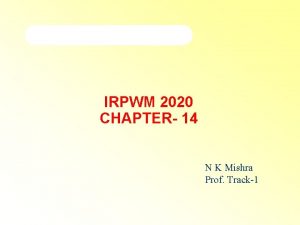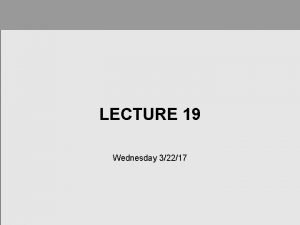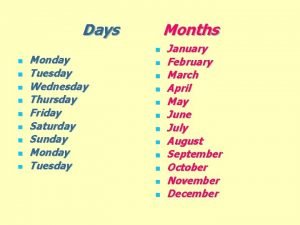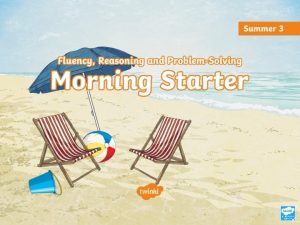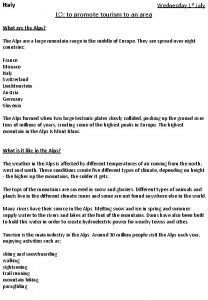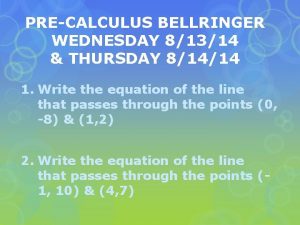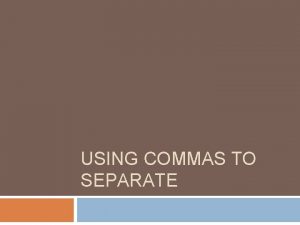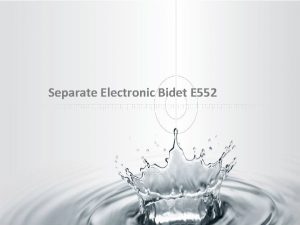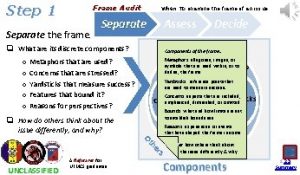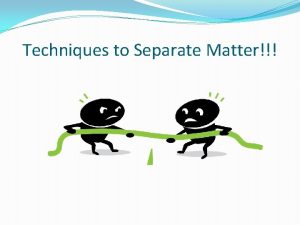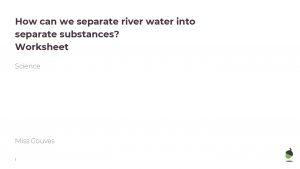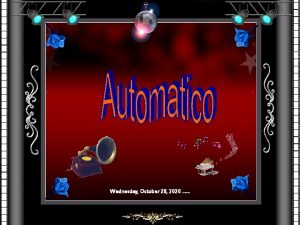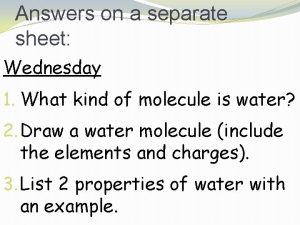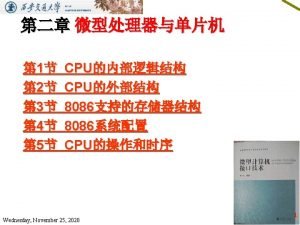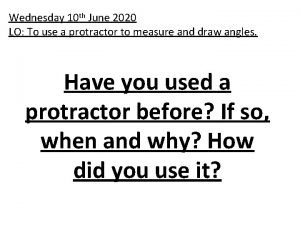Wednesday 17 th June 2020 LG to separate


































- Slides: 34


Wednesday 17 th June 2020 LG: to separate mixtures using filtering, sieving and evaporating.

Task: 10 - 15 mins • Find out what a mixture is and what different types of mixtures there are. • Explore how we can separate mixtures – sieving, filtering and evaporating. You might want to refer back to your vocabulary task from week 1 if you’re not sure what some words mean.

A mixture is two or more substances that are not chemically combined.

A mixture can be: • A combination of different gases, like air, which is a mixture of mostly nitrogen and oxygen. • A mixture of solids, like a salad. • A mixture of liquids, like squash, which is orange cordial and water. • Or any combination of gases, liquids and solids.

Mud is a mixture of soil and water, often with some bubbles of air inside too. Mist is a mixture of water droplets in air.

As the materials don’t change chemically when they mix, they can be physically separated, on the basis of their physical properties. In this picture, you can easily see the different colours of sweets. You can separate them based on the physical property of colour.

There are several different ways of separating mixtures. The best process to use depends on the type of mixture you are separating. Evaporation We’re not looking at these ways but they are used to separate things. Sieving Filtering Magnetism Decanting

https: //www. youtube. com/watch? v=JJe. Y-mu. Iqhw

Sieving

How do fishermen try to make sure they only catch adult fish and leave the young behind? It’s thanks to their net. The holes allow younger, smaller fish to escape while keeping the big, usually older fish inside. A net is a type of sieve. A sieve separates solids that are different sizes.


Sieving can separate large particles of solid from small particles. We use sieving to separate a mixture of different sized solids.

The mixture is poured into a sieve held over a bowl. The smaller particles will get through it into the bowl and the larger particles will be caught in the sieve. An example is sieving pebbles from sand.

Practical demonstration: Choose one material from each categories and mix them together. Then put them trough a sieve to see if you can separate them. Flour Icing sugar Caster sugar Sand Dry beans Sweets Pasta Rice Were you successful? If not, what do you think needs changing so you could separate your mixture?

Filtering

Fresh coffee is made by grinding up coffee beans to produce coffee grounds. These are then mixed with hot water. The coffee flavour and colour particles dissolve in the water forming a coloured solution, but the coffee grounds are insoluble (they do not dissolve in a liquid).

In the early 1900 s people drinking coffee would always get these coffee grounds in their mouth, which didn't taste nice!

A German lady called Melitta Bentz wanted to fix this problem.

She tore out some paper from her son’s notebook to line her coffee pot. Water is able to pass through the paper, but the grounds cannot. Bentz had invented the modern paper coffee filter, and these are still used today.

Insoluble solids do not dissolve in the liquid. The solid particles are not able to get through the tiny holes in the filter paper, and will be caught in it. Sand The liquid particles will go through the filter paper into the beaker below. This separation process is called filtration. Water

Filtration separates a liquid from an insoluble solid. It uses a material that allows the liquid or gas to pass through it, but not the solid. Filter paper Funnel

Practical demonstration: Make a mixture of sand/soil/flour and water. Use a piece of paper or a cake case to line a sieve or funnel. Put this over a bowl or cup. Pour the mixture onto the paper.

Evaporation

When a solid like salt is mixed with water, it dissolves (more on this next week). It looks like the solid has disappeared. We call a solid that dissolves soluble.

Evaporation is used to separate a liquid from a soluble solid. Water evaporates Salty water heat Salt is left in the dish The solution is heated until the liquid evaporates, leaving the solid behind.

The sun evaporates the water on salt farms to leave the salt we use to add to our food.

Practical demonstration: Dissolve some salt or sugar into water. Mix it until you can’t see the salt or sugar any more. Pour the solution on to a plate and leave it out until the water evaporates (This could take a couple of days). What can you see? Where is the water?

What separating technique would you use to separate the following? Filtering Sieving Evaporating MIXTURE PROCESS TO SEPARATE IT rice + pasta shapes Sieving paperclips + sawdust Sieving salt + water Evaporating flour + rice Move me! Sieving sugar + water Evaporating sand + water Filtering

Task: 10 - 15 mins Draw a diagram to explain each of these processes.

Extension Tasks: 15 mins + Experiment with separating other mixtures. Watery mixes Dry mixes squash + water mud salt + water oil + water (see decanting) sugar + water sand + water paperclips + sawdust flour + rice + pasta shapes sand + salt raisins + rice flour + sugar

Ancient Egyptians used to collect water from the Nile in large jars. They were left to stand to allow mud, sand & silt to settle at the bottom. Tipping the jar carefully allowed the solid (silt) and water to be separated, so that the water could be used. This process is called decanting.

Decanting This process can be used to separate two liquids that have different densities. The mixture of liquids is left to settle, so the two liquids are visible as two different layers. The less dense liquid will be the top layer, and this can be decanted, or slowly poured off. oil water This process could be used to separate a mixture of oil and water. Photo courtesy of dvanzuijlekom (@flickr. com) - granted under creative commons licence - attribution

Magnetism Use this process to separate magnetic materials from non-magnetic materials. A magnet is used to attract any magnetic materials and remove them from the mixture. You could separate a mixture of copper nails and iron nails using this process. Photo courtesy of oskay (@flickr. com) - granted under creative commons licence - attribution
 Irpwm june 2020
Irpwm june 2020 English class is wednesday
English class is wednesday Wednesday two of the key
Wednesday two of the key Monday tuesday wednesday thursday friday saturday sunday
Monday tuesday wednesday thursday friday saturday sunday Fe exam results wednesday
Fe exam results wednesday Wednesday lunch
Wednesday lunch Happy wednesday february
Happy wednesday february Marvelous monday terrific tuesday wonderful wednesday
Marvelous monday terrific tuesday wonderful wednesday Monday=621 tuesday=732 wednesday=933
Monday=621 tuesday=732 wednesday=933 Tuesday wednesday saturday
Tuesday wednesday saturday Ib physics hl grade boundaries
Ib physics hl grade boundaries Thursday prayer
Thursday prayer Wednesday journal prompts
Wednesday journal prompts Wednesday
Wednesday Wednesday phonics
Wednesday phonics Happy wednesday
Happy wednesday Monday is my favourite day
Monday is my favourite day Enum day sunday=1 monday tuesday=5
Enum day sunday=1 monday tuesday=5 Monday tuesday wednesday thursday friday calendar
Monday tuesday wednesday thursday friday calendar Wednesday lo
Wednesday lo Wise word wednesday
Wise word wednesday Web analytics wednesday
Web analytics wednesday Wednesday bell ringer
Wednesday bell ringer Wednesday bell work
Wednesday bell work Tuesday-sunday
Tuesday-sunday Happy wednesday
Happy wednesday Skinny wednesday
Skinny wednesday Wednesday bellwork
Wednesday bellwork Wednesday evening prayer
Wednesday evening prayer Wednesday at 6
Wednesday at 6 Happy wednesday march
Happy wednesday march Wednesday syllables
Wednesday syllables Again
Again Wednesday bellringer
Wednesday bellringer Monday=621 tuesday=732 wednesday=933
Monday=621 tuesday=732 wednesday=933
